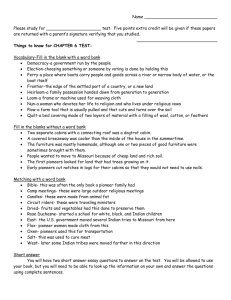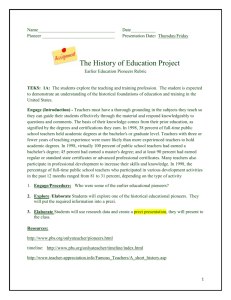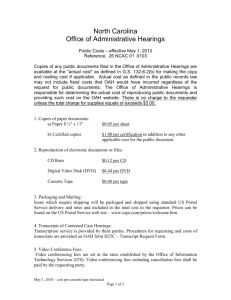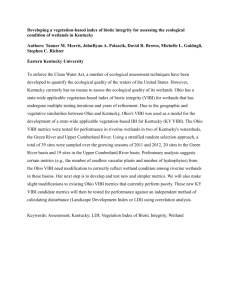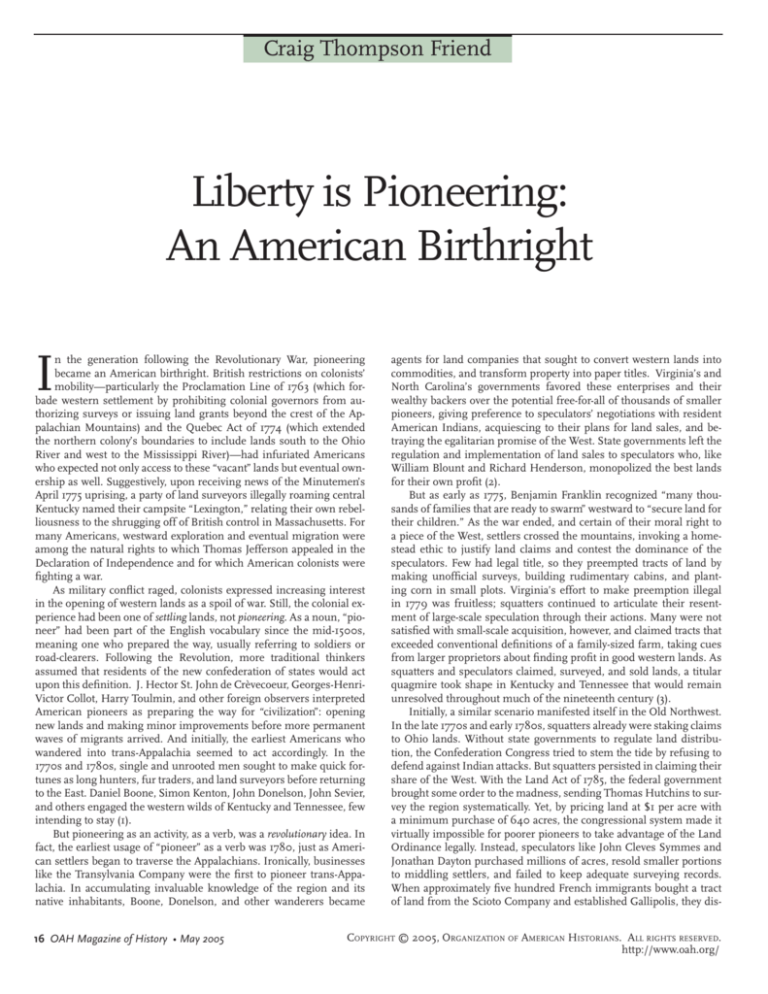
Craig Thompson Friend
Liberty is Pioneering:
An American Birthright
I
n the generation following the Revolutionary War, pioneering
became an American birthright. British restrictions on colonists’
mobility—particularly the Proclamation Line of 1763 (which forbade western settlement by prohibiting colonial governors from authorizing surveys or issuing land grants beyond the crest of the Appalachian Mountains) and the Quebec Act of 1774 (which extended
the northern colony’s boundaries to include lands south to the Ohio
River and west to the Mississippi River)—had infuriated Americans
who expected not only access to these “vacant” lands but eventual ownership as well. Suggestively, upon receiving news of the Minutemen’s
April 1775 uprising, a party of land surveyors illegally roaming central
Kentucky named their campsite “Lexington,” relating their own rebelliousness to the shrugging off of British control in Massachusetts. For
many Americans, westward exploration and eventual migration were
among the natural rights to which Thomas Jefferson appealed in the
Declaration of Independence and for which American colonists were
fighting a war.
As military conflict raged, colonists expressed increasing interest
in the opening of western lands as a spoil of war. Still, the colonial experience had been one of settling lands, not pioneering. As a noun, “pioneer” had been part of the English vocabulary since the mid-1500s,
meaning one who prepared the way, usually referring to soldiers or
road-clearers. Following the Revolution, more traditional thinkers
assumed that residents of the new confederation of states would act
upon this definition. J. Hector St. John de Crèvecoeur, Georges-HenriVictor Collot, Harry Toulmin, and other foreign observers interpreted
American pioneers as preparing the way for “civilization”: opening
new lands and making minor improvements before more permanent
waves of migrants arrived. And initially, the earliest Americans who
wandered into trans-Appalachia seemed to act accordingly. In the
1770s and 1780s, single and unrooted men sought to make quick fortunes as long hunters, fur traders, and land surveyors before returning
to the East. Daniel Boone, Simon Kenton, John Donelson, John Sevier,
and others engaged the western wilds of Kentucky and Tennessee, few
intending to stay (1).
But pioneering as an activity, as a verb, was a revolutionary idea. In
fact, the earliest usage of “pioneer” as a verb was 1780, just as American settlers began to traverse the Appalachians. Ironically, businesses
like the Transylvania Company were the first to pioneer trans-Appalachia. In accumulating invaluable knowledge of the region and its
native inhabitants, Boone, Donelson, and other wanderers became
16 OAH Magazine of History • May 2005
agents for land companies that sought to convert western lands into
commodities, and transform property into paper titles. Virginia’s and
North Carolina’s governments favored these enterprises and their
wealthy backers over the potential free-for-all of thousands of smaller
pioneers, giving preference to speculators’ negotiations with resident
American Indians, acquiescing to their plans for land sales, and betraying the egalitarian promise of the West. State governments left the
regulation and implementation of land sales to speculators who, like
William Blount and Richard Henderson, monopolized the best lands
for their own profit (2).
But as early as 1775, Benjamin Franklin recognized “many thousands of families that are ready to swarm” westward to “secure land for
their children.” As the war ended, and certain of their moral right to
a piece of the West, settlers crossed the mountains, invoking a homestead ethic to justify land claims and contest the dominance of the
speculators. Few had legal title, so they preempted tracts of land by
making unofficial surveys, building rudimentary cabins, and planting corn in small plots. Virginia’s effort to make preemption illegal
in 1779 was fruitless; squatters continued to articulate their resentment of large-scale speculation through their actions. Many were not
satisfied with small-scale acquisition, however, and claimed tracts that
exceeded conventional definitions of a family-sized farm, taking cues
from larger proprietors about finding profit in good western lands. As
squatters and speculators claimed, surveyed, and sold lands, a titular
quagmire took shape in Kentucky and Tennessee that would remain
unresolved throughout much of the nineteenth century (3).
Initially, a similar scenario manifested itself in the Old Northwest.
In the late 1770s and early 1780s, squatters already were staking claims
to Ohio lands. Without state governments to regulate land distribution, the Confederation Congress tried to stem the tide by refusing to
defend against Indian attacks. But squatters persisted in claiming their
share of the West. With the Land Act of 1785, the federal government
brought some order to the madness, sending Thomas Hutchins to survey the region systematically. Yet, by pricing land at $1 per acre with
a minimum purchase of 640 acres, the congressional system made it
virtually impossible for poorer pioneers to take advantage of the Land
Ordinance legally. Instead, speculators like John Cleves Symmes and
Jonathan Dayton purchased millions of acres, resold smaller portions
to middling settlers, and failed to keep adequate surveying records.
When approximately five hundred French immigrants bought a tract
of land from the Scioto Company and established Gallipolis, they dis-
COPYRIGHT © 2005, ORGANIZATION OF AMERICAN HISTORIANS. ALL RIGHTS RESERVED.
http://www.oah.org/
Rivers often provided the best routes to the new land on the frontier. The men above demonstrate how to use a raft designed in 1818 to make navigation easier. (Image
courtesy of the Department of State Patent Office, National Archives and Records Administration, ARC #594909.)
covered that their agent had not forwarded their payments to the company and that the company did not have actual title to the lands! As in
Kentucky and Tennessee, early Ohio’s overlapping claims and confused
titles led to legal challenges well into the nineteenth century (4).
Battles between squatters and speculators, often fought in the
courts, evinced the hunger for acquiring and retaining control of land.
Later, federal control of the public domain north of the Ohio and south
of Tennessee would redirect squatter animosity toward the government
itself and transform a chaos of litigation into a chronic political controversy. But either way, private property and individual rights constituted the foundation of the republic, as James Madison conceded: “The
rights of property are committed into the same hands with personal
rights.” But ownership was not enough: land provided opportunity for
private profit.
As James Fenimore Cooper described in his literary exploration of
The Pioneers (1823), the action of pioneering included immediate profiting from land ownership. “It is a singular feature in American life, that,
at the beginning of this [nineteenth] century, when the proprietor of the
estate, had occasion for settlers, on a new settlement and in a remote
county, he was enabled to draw them from among the increased of the
former colony.” There was a steady stream of new settlers pouring from
the East, particularly from the cities where population densities placed
too large a strain on rudimentary infrastructures, from New England
where land was at a premium, and from the southern backcountries
where fur traders and long hunters had already established ties with
trans-Appalachia (5).
To be successful, settlers sought out lands with uncontested titles
(or at least with the appearance of clearly defined titles), accessibility
to roadways or waterways that would bind residents to economic and
social networks, and freedom from the threat of Indian attack. Areas
east of the Appalachians—for example, William Cooper’s tract in upstate New York and South Carolina’s Long Canes district—offered such
advantages and commanded high prices as a result. In trans-Appalachia, however, land titles continued to be problematic, transportation
was impeded by the mountains to the east and alternating Spanish and
French control of New Orleans to the southwest, and Indians remained
powerful deterrents to white migration both north and south of the
Ohio River.
Many Native Americans wished to maintain their traditional lifestyles and viewed American encroachment on western lands as threatening to their cultural ways. Others had become economically involved
with the earliest long hunters and fur traders, modifying cultural patterns of reciprocal gift-giving to allow for profit and more materialistic
consumption: alcohol, blankets, guns, clothing. Settlement in hunting
grounds, in this case by increasingly large numbers of whites, contested the moral foundation for American Indians’ traditional cultures and
reduced Indian participation in the fur trade. Indians reacted violently,
attacking white farmsteads and small settlements, trying to frighten
pioneers out of the West. Significantly, Indians who had joined in profit-making and material consumption did not commodify land. While
federal troops, waves of white settlers, and the loss of the hunting lands
certainly undermined native cultures, the Indians’ own emphasis on
communal land usage rather than private property ownership may have
been most detrimental. They could not conform to new land usages that
accompanied the commercial and consumer revolution overtaking their
villages, the cornerstone of which was the idea of private property (6).
COPYRIGHT © 2005, ORGANIZATION OF AMERICAN HISTORIANS. ALL RIGHTS RESERVED.
http://www.oah.org/
OAH Magazine of History • May 2005 17
Even if successful in gaining some degree of security from the Indians, pioneers benefited little from land ownership if transportation
routes were poor. Natural routes such as the Ohio River and the Wilderness Road through the Cumberland Gap connected eastern economic
and social networks to western settlements. Merchants in Pittsburgh,
Marietta, Lexington, Louisville, Cincinnati, and St. Louis imported
goods from eastern suppliers. Communication arrived in the form
of eastern newspapers. Eastern bank notes kept the west financially
bound to Philadelphia, Baltimore, and Alexandria. Baptist, Methodist,
Catholic, Episcopal, and Presbyterian officials sent ministers and circuit riders into trans-Appalachia to extend denominational influence.
The East maintained strong ties to the West (7).
But the impediments of the Appalachian Mountains, inconsistent
access to the port of New Orleans, and other problems idiosyncratic to
western life made pioneers’ sense of unity with the East tenuous. In
the 1780s, the Confederation Congress attempted to bring some order
to the West, but the founding generations’ vision of a harmonious and
stable society led by aristocrats quickly disintegrated as landowners in
the Scioto Valley of Ohio, along the Maysville Road in Kentucky, in Tennessee’s Military Reservation, and elsewhere promoted private interest
as the cornerstone of the public good. Indeed, many pioneers began to
view the Land Ordinance and the few other Confederation measures
as restrictive and incompatible with private profit. Then, in 1784 the
Spanish closed the Mississippi River to American shipping and pioneers pleaded with the Confederation Congress to intervene. For two
years John Jay negotiated with his Spanish counterpart, Don Diego de
Gardoqui, but the treaty they produced in 1786 sacrificed western pioneers’ needs to eastern merchants’ desires for direct trade with Spain.
Under pressure from the West, Congress would not ratify the treaty.
The terms of the failed Jay-Gardoqui Treaty deepened westerners’
distrust of the East, which had simmered since the beginning of the
Revolution. Immediately after the war General James Wilkinson had
migrated to Lexington, Kentucky, to open a store, and within four years
he was privately advocating secession and protection under Spanish
rule, with a modicum of success. The rumblings of secession circulated for a decade. Only Spain’s agreement to Pinckney’s Treaty in 1795,
which granted American navigation rights along the Mississippi River
subject to duties, quieted these persistent secessionist rumors.
By the 1790s, with Federalists firmly in control of the newly formed
federal government, hundreds of pioneers sent petitions demanding
free navigation of the Mississippi River through New Orleans, federal
troops to fend off Native Americans, and resolution of land title disputes. Their appeals should not be surprising: government, albeit in
the form of county courts, had been a regulating force in economic development throughout the settlement process. But pioneers and their
local courts had proved themselves incapable of resolving the Indian
problem or the quagmire of land titles in the Southwest. Further, they
had no power to negotiate with foreign nations. National leaders responded by sending John Jay to England in 1794 to negotiate, successfully, a reduction of the British presence on the northwestern frontiers.
The following year, Thomas Pinckney visited Spain and secured free
navigation of the Mississippi River for three years, restraint of Spanishsupported Indians on the southwestern frontiers, and recognition of
West Florida’s boundary at the 31st parallel. Jay’s Treaty proved unpopular, especially for its failure to address eastern interests, but Pinckney’s
Treaty was greeted enthusiastically.
Both, however, effectively transformed the West. Northwestern Indians, chastised by federal troops under Anthony Wayne at the Battle of
Fallen Timbers in August 1794, found themselves deserted by British
garrisons retreating under the terms of Jay’s Treaty. Forced to come to
terms with American pioneers, they yielded a spacious tract of Ohio
Valley land in the Treaty of Greenville in 1795. Southwestern Indians
18 OAH Magazine of History • May 2005
could no longer rely on the patronage of Spanish officials in New Orleans, and neither could western secessionists. By curbing the Indian
menace and opening the Mississippi River, Pinckney’s Treaty temporarily quieted pioneer discontent.
Federalist actions laid the groundwork for economic and political
transformations over the next two decades that would sweep trans-Appalachian pioneers into prosperity. Most pioneers took up farming, the
quintessential American activity, since it allowed one to benefit immediately from owning land. Nathaniel Hart was ten years old when his
family moved westward. A member of the generation born after the
Revolutionary War whose lives paralleled the ideological, economic,
and territorial creation of the United States, he inherited the promise
of liberty that his father and thousands of other Americans had secured
through war, including the conventional wisdom that the West was a
place where that promise was most easily fulfilled. Unlike his father,
who owned a ropewalk, Nathaniel aspired to be a farmer and projected
his start-up costs as $6000 for a house, $1000 for a distillery, $500 to
construct a mill, and another $500 for a barn. “When this is all done
if I do not break in doing it,” he concluded, “I hope to be in a situation to make money.” Obviously, his farm was not the average yeoman
homestead; his intentions, however, mirrored the aspirations of most
pioneers (8).
Rising European demands for agricultural produce stimulated
western farming and exports and rewarded pioneers who pursued the
market. Not surprisingly, therefore, westerners turned to the emerging
Democratic-Republican Party to represent their interests and secure
their inheritance of pioneering as liberty. With the election of 1800,
most of the West joined Jefferson in his vision of an agrarian republic in which pioneer farmers’ needs were paramount. But this western
agrarian republic was not the simplistic, subsistence-oriented economy
that has come to dominate historical understanding of the trans-Appalachian pioneers. Like their friends and relatives east of the Appalachians, westerners were too tempted by the market economy to settle
for mere subsistence. Regional newspapers celebrated not only the
agrarian ideal but also the profit that could accompany it:
Look round your farms—how rich the prospect seems!
The orchard bends, the field luxurious teems!
Here Agriculture opens to our view,
A land of milk and honey, rich and new.
Corn—which historically represented the first efforts at claiming
land and eking out an existence in the wilderness—quickly became
the major cash crop. Between 1799 and 1802, profits earned from the
export of Kentucky corn equaled the value of goods imported into the
state. As pioneer migration accelerated, so too did market participation. By 1802, so many farmers entered into the Ohio River Valley corn
trade that regional prices plummeted to unprecedented levels. By 1805,
however, production was on the rebound; Kentucky merchant Daniel
Halstead applauded how the profits from corn and other agricultural
productions again “over Balance the in ports.” The musings of one pioneer restated the point in a more lyrical manner:
May the Lord be praised
how I am a mased
to see how things have mended
hot cake and tea
for supper I see
When mush and milk was intended.
Subsistence was never the objective; it was just a temporary consequence of relocation (9).
COPYRIGHT © 2005, ORGANIZATION OF AMERICAN HISTORIANS. ALL RIGHTS RESERVED.
http://www.oah.org/
The mad rush of merchants into trans-Appalachia symbolized the
Endnotes
1. J. Hector St. John de Crèvecoeur, Letters from an American Farmer (1782; reprint,
quick conversion of the region from subsistence into a pioneer market
Gloucester, MA: Peter Smith, 1968); Georges-Henri-Victor Collot, A Journey
economy. Any farmer could participate, and any merchant could become
in North America: containing a survey of the countries watered by the Mississippi,
a middleman. It should not be too surprising, then, that many men of
Ohio, Missouri, and other affluing rivers. . .followed by. . .a projected line of frontiers
commerce became western political leaders, in both the Federalist and
and general limits, 2 vols. (1826; reprint, Florence, Italy: O. Lange, 1924); Harry
Democratic-Republican parties. The two parties shared the vision of a
Toulmin, A Description of Kentucky in North America, ed. Thomas D. Clark
western republic led by aristocrats, and as men of commerce, local and
(Lexington: University of Kentucky Press, 1945); “Pioneer,” in Noah Webster,
regional political leaders increasingly positioned themselves as that arAn American Dictionary of the English Language (New York: S. Converse, 1828),
istocracy. It was Democratic-Republican farmers and merchants, hown.p. “Long hunters” were men who hunted for several months at a time in the
trans-Appalachian West, consequently leaving their families abandoned east
ever, who argued that individual pursuit of profit contributed to larger
of the mountains.
societal advancement. Indeed, it was not a market revolution that they
2. “Pioneer,” in Webster, An
feared (to the contrary, they
American Dictionary of the Engearly and eagerly tapped into
lish Language, n.p.
it), but rather unwelcome
3. Benjamin Franklin, “A Plan
federal, state, and corporate
for Settling Two Western Coloregulation—including charnies,” in The Papers of Benjamin
tered banks, inspection staFranklin, ed. Leonard W. Labaree
et al., 30 vols. (New Haven, CT:
tions, and companies—that
Yale University Press, 1959-),
threatened individual pursuit
5: 456-62; Stephen Aron, How
and societal harmony.
the West Was Lost: The TransforJeffersonian
partisans,
mation of Kentucky from Daniel
then, provided a political
Boone to Henry Clay (Baltimore:
context for the pioneering
Johns Hopkins University Press,
activity underway in trans1996), 58-101; John R. Finger,
Appalachia. In contrast to the
Tennessee Frontiers: Three Regions
in Transition (Bloomington: In1780s and early 1790s, when
diana University Press, 2001),
westerners were hard pressed
99-124.
to find any government truly
4. R. Douglas Hurt, The Ohio
interested in their problems,
Frontier: Crucible of the Old Norththe late 1790s and early 1800s
west, 1720-1830 (Bloomington:
witnessed the mainstreamIndiana University Press, 1996),
ing of pioneer concerns into
189-97; Andrew R.L. Cayton,
partisan politics. Jeffersonian
The Frontier Republic: Ideology
and Politics in the Ohio Country,
Republicans wished to make
1780-1825 (Kent, OH: Kent State
the West accessible to as many
University Press, 1986), 12-50.
pioneers as would take up the
5. Madison, Federalist 54, in Clinchallenge, ensuring the sucton Rossiter, ed., The Federalist
cess of a combined agrarian
Papers: Hamilton, Madison, Jay
and commercial economy (10).
(New York: Mentor Books, 1961),
For the generation follow339; James Fenimore Cooper, “Ining the Revolutionary War,
troduction [1832],” in The Pioneers,
ed. James D. Wallace (New York:
then, pioneering allowed them
Oxford University Press, 1991).
to pursue private interests, ac6.
Colin
G.
Calloway,
quire and sell land, grow and
“Maquachake: The Perils of Neuexport agricultural productrality in the Ohio Country,” in
tions, and construct an econCalloway, The American Revoluomy (and consequently a poltion in Indian Country: Crisis and
ity and society) that reflected
Diversity in Native American Comtheir faith in private property,
munities (Cambridge: Cambridge
University Press, 1995), 158-81; A.
individual pursuits, and other
Gwynn Henderson, “The Lower
natural rights so eloquently
phrased in the Declaration of “Hunter’s of Kentucky. Or half horse and half alligator.” This broadside includes a poem Shawnee Town on Ohio: Sustaining Native Autonomy in an Indian
Independence. The signifi- describing the valor of Kentuckians at the Battle of New Orleans during the War of 1812. De‘Republic,’” in Craig Thompson
cance of this opportunity was scribing them as “half-horse” and “half-alligator,” the poem emphasizes the fierce image of Friend, ed., The Buzzel About Kenmost evident as the first gen- the frontiersman. (Image courtesy of the Filson Historical Society.)
tuck: Setting Up the Promised Land
eration of westerners reached
(Lexington: University Press of
their elder years. In the 1840s, as Leatherstocking Tales and stories of AlKentucky, 1999), 25-56.
7. Craig Thompson Friend, Along the Maysville Road: The Early Republic in the Trans-Apligator-Horse Men transformed American culture, “pioneer” became an
palachian West (Knoxville: University of Tennessee Press, forthcoming); Kim Gruadjective, labeling those who had opened the West and the future based
enwald, River of Enterprise: The Commercial Origins of Regional Identity in the Ohio
on revolutionary ideals three generations hence. It revitalized the myth
Valley, 1790-1850 (Bloomington: Indiana University Press, 2002); Marion Winship,
of the pioneer in nineteenth-century America, and inspired continued
“Kentucky in the New Republic: A Study of Distance and Connection,” in Friend,
migration to the West where liberty continued to be pioneering (11). ❑
The Buzzel About Kentuck, 101-24.
COPYRIGHT © 2005, ORGANIZATION OF AMERICAN HISTORIANS. ALL RIGHTS RESERVED.
http://www.oah.org/
OAH Magazine of History • May 2005 19
MEMBERSHIP ENROLLMENT FORM
Join online at <www.oah.org> or return this form with payment.
NAME
ADDRESS
CITY
STATE
ZIP
Check enclosed (must be drawn in U.S. funds, on U.S. bank)
Visa
MasterCard
CARD NUMBER
EXPIRATION DATE
SIGNATURE
History Educator Membership
Receive the OAH Magazine of History, OAH Newsletter, and Annual
Meeting Program.
$40 Designed especially for historians whose primary interest
is teaching.
Student Membership
Receive the OAH Newsletter and the Annual Meeting Program,
and in addition choose between receiving the Journal of American
History or the OAH Magazine of History.
$25 Check one: Journal Magazine
STATUS:
SCHOOL:
ADVISOR:
Standard Membership
Receive the Journal of American History, OAH Newsletter, and the
Annual Meeting Program. (Check appropriate income/dues category.)
$40 Income under $20,000
$55 Income $20,000 – 29,999
$75 Income $30,000 – 39,999
$85 Income $40,000 – 49,999
$95 Income $50,000 – 59,999
$105 Income $60,000 – 69,999
$115 Income $70,000 – 79,999
$130 Income $80,000 and over
Other Membership Categories
Receive the Journal of American History, OAH Newsletter, and the
Annual Meeting Program.
$150 Contributing Member (extra support for the organization)
$55 Associate Member (not employed as a historian)
$45 Emeritus or Retired
$25 50 Year OAH Member (50+ years of membership)
$40+ Dual—share OAH publications but receive all other individual benefits (Select income category for first member,
and add $40 for second.)
DUAL MEMBER NAME:
Overseas Postage
$20+ Add extra fee for shipping outside the U.S.
For additional information on OAH membership
benefits, or institutional subscriptions, please visit:
<www.oah.org/members/mbrinfo.html>.
PLEASE RETURN FORM TO:
OAH, P.O. Box 5457, Bloomington IN, 47408-5457
Organization of American Historians
phone: 812.855.7311
e-mail: <member@oah.org>
20 OAH Magazine of History • May 2005
8. Nathaniel Hart to James McDowell, June 18, 1809, James McDowell Papers,
State Historical Society of Wisconsin, Madison; Craig Thompson Friend,
“‘Work & Be Rich’: Economy and Culture on the Bluegrass Farm,” in Friend,
The Buzzel About Kentuck, 125-52.
9. Kentucky Gazette, October 2, 1798; François André Michaux, Travels to the West
of the Alleghany Mountains, in Early Western Travels, 1748-1846, ed. Reuben Gold
Thwaites, 32 vols. (Cleveland: Arthur H. Clarke, Co., 1904-1907), 3: 205, 239;
William Faux, Memorable Days in America, part I, in Thwaites, ed., Early Western
Travels, 1748-1846, 11: 187; Laws of Kentucky, 2 vols. (Lexington, KY: John Bradford, 1799), 2: 411-3; Daniel Halstead to Alex Sanders, 1805, Daniel Halstead Account Books, 1797-1830, Filson Historical Society, Louisville, KY; inside cover of
Mason County, Kentucky, Account Book 1797-1799, Filson Historical Society.
10. Drew R. McCoy, The Elusive Republic: Political Economy in Jeffersonian America (Chapel Hill: University of North Carolina Press, 1980); Andrew R.L.
Cayton, Frontier Indiana (Bloomington: Indiana University Press, 1996);
Fredrika Johanna Teute, “Land, Liberty, and Labor in the Post-Revolutionary Era: Kentucky as the Promised Land” (Ph.D. diss., Johns Hopkins University, 1988)
11. “Pioneer,” in Webster, An American Dictionary of the English Language, n.p.;
Cooper, The Pioneers; Michael Allen, Western Rivermen, 1763-1861: Ohio and
Mississippi Boatmen and the Myth of the Alligator Horse (Baton Rouge: Louisiana State University Press, 1990).
Suggestions for Further Reading
Aron, Stephen. How the West was Lost: The Transformation of Kentucky from Daniel Boone to Henry Clay. Baltimore: Johns Hopkins University Press, 1996.
Brooks, Charles E. Frontier Settlement and Market Revolution: The Holland Land
Purchase. Ithaca, NY: Cornell University Press, 1996.
Cashin, Joan E. A Family Venture: Men and Women on the Southern Frontier. New
York: Oxford University Press, 1991.
Cayton, Andrew R. L. Frontier Indiana. Bloomington: Indiana University
Press, 1996.
———. The Frontier Republic: Ideology and Politics in the Ohio Country, 1780-1825.
Kent, OH: Kent State University Press, 1986.
Dupre, Daniel S. Transforming the Cotton Frontier: Madison County, Alabama,
1800-1840. Baton Rouge: Louisiana State University Press, 1997.
Faragher, John Mack. Sugar Creek: Life on the Illinois Prairie. New Haven, CT:
Yale University Press, 1986.
Finger, John R. Tennessee Frontiers: Three Regions in Transition. Bloomington: Indiana University Press, 2001.
Friend, Craig Thompson. Along the Maysville Road: The Early American Republic in
the Trans-Appalachian West. Knoxville: University of Tennessee Press, 2005.
———, ed. The Buzzel About Kentuck: Settling the Promised Land. Lexington:
University Press of Kentucky, 1999
Hinderaker, Eric. Elusive Empires: Constructing Colonialism in the Ohio Valley,
1673-1800. Cambridge: Cambridge University Press, 1997.
Hurt, R. Douglas. The Ohio Frontier: Crucible of the Old Northwest, 1720-1830.
Bloomington: Indiana University Press, 1996.
Linklater, Andro. Measuring America: How the United States was Shaped by the
Greatest Land Sale in History. London: HarperCollins Publishers, 2002.
Mitchell, Robert D., Commercialism and Frontier: Perspectives on the Early Shenandoah Valley. Charlottesville: University Press of Virginia, 1977.
Perkins, Elizabeth A. Border Life: Experience and Memory in the Revolutionary
Ohio Valley. Chapel Hill: University of North Carolina Press, 1998.
Rohrbough, Malcolm J. The Trans-Appalachian Frontier: People, Societies, and Institutions, 1775-1850. New York: Oxford University Press, 1978.
Thornton, J. Mills, III. Politics and Power in a Slave Society: Alabama 1800-1860.
Baton Rouge: Louisiana State University Press, 1978.
Craig Thompson Friend is Associate Professor of History at the University
of Central Florida and editor of the Florida Historical Quarterly. He has
authored Along the Maysville Road: The Early Republic in the TransAppalachian West (Knoxville: University of Tennessee Press, 2005) and
edited The Buzzel About Kentuck: Settling the Promised Land (Lexington: University Press of Kentucky, 1999). He is currently working on
The Kentucky Frontiers: From New West to Old South for Indiana
University Press.
COPYRIGHT © 2005, ORGANIZATION OF AMERICAN HISTORIANS. ALL RIGHTS RESERVED.
http://www.oah.org/


